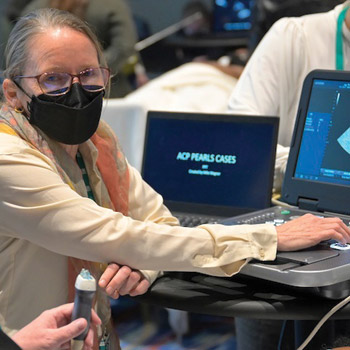Advocacy is a marathon that mimics our patient encounters
We do advocacy work on a daily basis when we see patients, and we have to approach our interactions with legislators in a similar way.
Given the recent experience of ACP Leadership Day 2022 on Capitol Hill, I would like to focus this column on advocacy. As a professional society, ACP has demonstrated value in the domains of education, professionalism, leadership, and advocacy. Advocacy is important to the College's work as we advocate for our patients and our profession. ACP has an office in Washington, D.C., separate from its headquarters in Philadelphia, where the Division of Governmental Affairs and Public Policy (DGAPP) staff are located. DGAPP is integral to the College's mission and serves as the primary support for two of ACP's national committees: Health and Public Policy and Medical Practice and Quality. The daily work done by the DGAPP staff is critical in addressing health care issues at the governmental and legislative level.
Some of our ACP Leadership Day priorities are readdressed over multiple years, and sometimes it can be daunting at the end of the day wondering if we have been successful in making an impact with our legislative interactions. Advocacy at the legislative level takes patience and time. Advocacy is a process where you have a targeted goal but understand that you have to chip away until you achieve it. The solutions to ACP legislative priority issues are not a sprint, but rather a marathon, as the priority agendas are faced with additional barriers, partisan loyalty, and regulatory red tape that takes time to navigate. Interestingly, we do advocacy work on a daily basis with our patient encounters, and we have to approach our interactions with legislators in a similar way.
How many times have you advised a patient to undergo a cancer prevention test (e.g., colonoscopy), receive a vaccine (e.g., influenza or COVID-19), or change a behavior (e.g., smoking or alcohol), only to see them repeatedly decline? I assume we all have encountered this in one way or another during our careers. We typically do not stop with the one-and-done approach where if patient declines, we leave the issue alone. If it is in the patient's best interest, we continue to make our recommendations for the betterment of their health and well-being.
For example, evidence shows that it takes a patient multiple attempts to be successful at smoking cessation. So, if we stopped after the first ask, we would miss the opportunity to continue to empower our patients to keep trying to change their behavior. Rather, we approach these patients using a multitargeted effort to impact change by attempting to understand their perspective (answering the why), clarifying any misinformation, explaining the consequences or negative impact on their health, relating a change in behavior to something they may find meaningful in their lives, and then attempting to find some common ground where we both can agree. Sometimes these efforts result in patients making small changes that we can build off of over time. The approach is basically meeting the patient where they are on a case-by-case basis and trying to slowly break down barriers.
The approach to advocacy with our legislature mimics that of our patient experiences. These priorities can take time, such as the prolonged advocacy for ending the previous reimbursement structure, called the Medicare Sustainable Growth Rate (SGR) formula. The College never wavered in its 10-year advocacy effort to delay yearly reimbursement cuts, until the SGR reimbursement formula was permanently repealed and transitioned toward a new conceptual approach of a value-based payment paradigm through the Medicare Access and CHIP Reauthorization Act of 2015 (MACRA). Despite the imperfections of the value-based replacement options, the Merit-Based Incentive Payment System (MIPS) and Alternative Payment Models (APM), the point is that ACP continued to fight this legislative battle until our voices were heard. Similar to our patient encounters, we have to meet each legislator where they are. Some will be in alignment, some will be undecided, and others will be against our approach. However, regardless of starting point, we have to continue advocating for the best interest of our profession and our patients.
Our advocacy strategies are quite similar to how we approach our patient interactions, as each interaction has to be individualized. Although we enter each legislative meeting with a policy agenda, it is important to understand dissenting or differing opinions in order to become more strategic in our approach to impact change. Listening is essential. We have to work to find common ground on a particular issue in order to develop a relationship and trust. This has to be combined with a skillful effort to show the evidence (beneficial since ACP is evidence-based) to support our asks and educate our policymakers on the potential or unintended consequences of their policy positions. Finally, we have to make it personal, with stories to help drive home our point from the constituents lawmakers serve. There is no simple recipe for success, as there are other regulatory and partisan barriers that are intertwined and create more complexity. However, we have to be engaged in advocacy for the marathon and slowly chip away at the issues, individualizing our approach, making it personal, and celebrating the small wins as we work toward the overall mission of our advocacy agendas.
Advocacy isn't always packaged with wins and losses. Sometimes success comes in compromise or in building relationships of trust and confidence, so that if one battle doesn't go your way, you may be better positioned as a valued resource for the next encounter. All advocacy should end in a call to action. Regardless of the outcome, we have to keep showing up each time and continue to advocate for what we believe is in the best interest of our patients and our profession. If we don't, who will?




